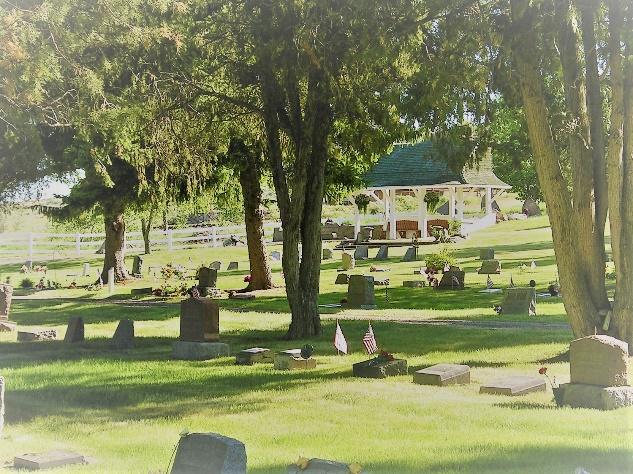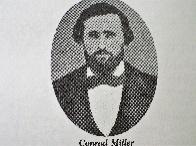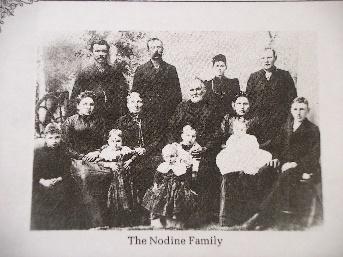Visit the Union Victorian Cemetery


Union Victorian Cemetery
Established 1862
The oldest Monument Cemetery in Northeastern Oregon
770 E. Fulton St.
PO Box 707
Union, OR 97883
541-562-5212
Unioncemetery2@eoni.com
Office hours 9:00-11:00
The Chapel
This building is reported to have been constructed in 1893 as a tool shed for the cemetery. In 1997 the Veterans took timbers from the old Union Flour mill and siding from an historic house and refurbished the shed into a Chapel.
Conrad Miller OS2-151-8
Just behind the chapel to the north you will find the marker for Conrad Miller who was the first white man to settle in the area in 1861. He built a cabin to spend his first winter in. In the spring of 1862 he decided to go back to Vancouver to purchase some fruit trees. When he returned he discovered 3 men had taken over the cabin. These men wanted the place for their own. Fred Nodine was asked to judge the case. Nodine discovered that Conrad had planted a garden before he left on his trip to Vancouver. Nodine felt that because of this Conrad had planned to return to his cabin so it was decided that the claim should belong to Miller. 
Jabaz Hinckley OS2-173-3
A group of miners were in Idaho discussing where to spend the upcoming winter when a man spoke up and said “Boys, I can tell you where to go for land. Go to Grande Ronde Valley, Oregon for it is the most beautiful valley I ever saw.” A couple of days after that Jabaz Hinckley and Cutting Clark started off for that valley. These are two of the men Conrad Miller found in his Cabin when he returned from his trip. (South of the Chapel)
Harriet Chapman OS2-140-10
Harriet and her husband J.A.J. Chapman are of the original settlers in the valley. We have no dates for her birth or death, just a note scrawled beside her name that says she is the first person buried in this Cemetery.
Frederick Nodine OS2-160-4
Fred, who was the judge in the case of Conrad Miller and Jabaz Hinckley, settled here in this valley in 1862. He built up one of the largest cattle ranches and became one of the wealthiest men in this area for over 20 years. He was known throughout the state because of his large cattle drives. Fred donated the land for this cemetery to be built upon he also donated the land for the public school. In the end however, through some bad investments Fred and his wife Eliza died here in Union among the impoverished. (Buried north of the gate to the walkway leading to the chapel)
Joseph and Catherine Upton OS2-146-5
Joseph was the first caretaker of this cemetery. They are buried in our only crypt.
Moses Lore OS2-157-8
Just to the north side of the Chapel lies the grave of Moses Lore, one of the first french canadians to come to Union. He came to the Oregon territory in the 1830’s. In 1839 he was working for Heny Spalding (a missionary working with the Nez Perce). He lived with the Indians for many years. He worked in the Rocky Mountains as a hunter and trapper of beaver and buffalo. He fought with Indians and robbers. He was a miner but found no gold only fever, ague and scurvy. He peddled merchandise until he finally made his way to Union in 1862. Here he became a farmer and stock raiser. He was married to Mary Sanders (a Chinook) and together they had 6 children, only one survived. Joseph Lore, Moses’ son is buried here close beside his father. OS2-157-06.
Albert J. Goodbrod OS2-138-5
Albert was born in Germany and as a young boy came with his family to America. Later he joined up with Company B, Scott’s 900, 1st United States Cavalry. A.J. Goodbrod is a veteran of the Civil War. He was wounded 9 times during his enlistment. He was shot down near Fairfax Courthouse and after lying on the field for 7 days and being passed over many times for dead, he was found by soldiers detailed to do the burying and taken to a Washington D.C. Hospital where he remained for 5 months. He was a farmer, served as Marshall and councilman and owned the Centennial Hotel.
James Pyle OS2-151-2 James was the first Senator from Union County. With each family working hard in doing their part to build this area James did his part by developing the road through Pyle’s Canyon. Much rock needed to be cleared away for the road. We also have buried here Keller Bartholemew OS2-225-8 and several others who are noted in our books as having been “killed in blasts while working in Pyle’s Canyon”.

James Myers OS2-225-3
Located just north of the office is the marker of James Myers and Thomas Smith. James Myers had a ranch on Balm Creek. He was preparring to retire from his freighting business and go into stock raising. On July 12, 1878 he was heading to Umatilla on his last run when James, Thomas and 2 other freighters were attacked by Indians. This most likely happened while they were still sleeping. They were killed at a point previously called Crawford’s Hill but became known as “Dead Man’s Pass”.
Jones Family OS2-232-1,2,3,4
There are several articles in the LaGrande Evening Observer from 12/1906 that tell the story of this family of 8. Apparently they ate some home canned beans for supper one night. After which they became sick. Within a few days the mother and 3 of the children had perished from Ptomaine poisoning.
Anna Ratz OS2-236-3
There is a mystery behind Anna’s death. In the East Oregonian it tells the story of Mrs. Ratz leaving her home sometime in the early morning. Her husband awoke to find her gone. He roused the neighbors around 4 a.m. to help in the search. Her clothes were found near the creek. Her body was not found until some hours later. She was discovered with her hands tied behind her back but in such a way that she could have done it herself. The inquest found no motive for suicide and yet it was not evident how anyone could entice her to leave her home. No more of this story is found in the paper.

OUTBREAKS
We find published in the papers stories from 1909 stating that Union had an outbreak of Diphtheria and also Scarlett Fever. The railroad was closed as well as churches and schools. A curfew was set up so that no one under the age of 19 could be on the streets. Many families lost their children. You will find many graves for children and some are marked by sheep.
National Cemetery History
(Information taken from the National Cemetery Administration web site)
For Veterans. Excerpts from “History of Government Furnished Headstones and Markers.” The original standard grave marker precedes the establishment of national cemeteries in 1862 and actually has its origin in the frontier days of this country prior to the Civil War. A wooden board with a rounded top became the standard. No centralized system for recording burials existed before then. In 1865, when burials in national cemeteries approached 100,000, serious consideration began to be given to long range economy to maintain the wooden headboards then in use. In 1873, the first design for stones was adopted. The Civil War-type of headstone was furnished not only for the unmarked graves of that war but for the unmarked graves of eligible deceased of the Revolutionary War, War of 1812, Mexican War, Spanish American War and Indian Campaigns. You will find several stones of this original design marking the graves of many brave Veterans in our cemetery. The stone has a rounded top with a shield emblem. It gives the soldiers Name, Rank and Company served. You can learn more about their service by looking up their company on line. There are many veterans buried here from various wars. 
William Conklin Cusick OS1-43-19
In 1864 William joined the Union Army as a volunteer. He was sent to the 1st OR Infantry where it was their duty to keep an eye on the Nez Perce Indians. However the native people remained quiet so William, with some time on his hands, sent for a book on botany. Sometime after being discharged he and his brother settled in the Powder Valley doing some ranching. For 4 decades Cusick undertook pioneering botanical explorations of the remote Wallowa and Blue Mountain ranges until blindness and deafness overcame him. At one time he had nearly 40 taxa (species) bearing the Cusick name and Mount. Cusick in Wallowa County is named for him.
Charles C. Coffinberry OS1-34-9
Charles left home, Ohio, at age 18 to become a peddler and sold goods throughout the country. In 1857 he went to Seneca Kansas and helped to lay out that city. He continued on his travels until he came to Union in about 1886 where he started up a carpenter trade.
While in Kansas he was elected for the state legislature and in addition he held many other offices in their government. When the war broke out he raised two companies of soldiers who became part of the 7th & 10th Kansas Cavalry. He helped to pass the prohibition bill in 1873.
The Saari Family OS1-83-4,5,6
In the old cemetery books we have one notation beside this family which reads, “Death seemingly rather mysterious.” This family of 3 died within a week of each other.
The Swackhamer Family OS1-27 graves 2-10 Father Samuel migrated to Union around 1862-63. He had a freighting business that took him to the Dalles, where he met his wife, Clara. He served several terms as the Sheriff of Union. 
It was while he was sheriff that tragedy struck his family. This is from an article in the July 5, 1879 Grant County Newspaper “Union Sentinel: An affliction that has befallen our respected citizen, Sheriff Swackhamer, has cast a gloom over the entire community. On last Sunday his youngest child was buried beside the fresh graves of its brother and three little sisters. But one child, the oldest of a family of six, remains; in the silent home of the dead, the victims of that fell destroyer, diphtheria.”
Samuel continued to serve in Union government in serveral different areas. 
Conrad Swackhamer is Samuel’s Father and Hiram Dodge is his wife Clara’s Father. OS2-161-6 Just south of the Chapel walkway.
The Phy Family OS1-5-1-10
John M. Phy brought his family with him to Oregon. Although he is buried elsewhere, his sons John F., Marshall, William, John A. and daughter Maggie are all buried here.
William T. Phy had the acclaim of being the proprietor of the Hot Lake Sanitorium, building it up to a prominence in the northwest. He was also a leading surgeon in the west. Hazel is his second wife. His son Mark was also a physician.
John A. Phy only lived to the age of 10. He was killed when a brother was moving a gun to put it away safely and it went off for an unknown reason hitting John in the head.
John F. Phy was the Sheriff of Union at the time of the Kelsey Porter murder case. John being reported as the one to fix the rope around the neck of Porter.
Kelsey Porter OS1-103-2
The only man legally hung in Union County. Porter was tried and found guilty for the shooting of the Mache family, Benjamen, Mary and their son 17-year-old Joseph on 1/1/1896. The hanging occurred 11/19/1897 at the old courthouse. This is now the Union High School and you can still see the barred windows at the back. You can find more information about this case by looking it up online.

Judge Robert Eakin OS1-29-9
Judge Eakin has his roots in Ireland. In 1866 his family moved to Eugene where he attended college. By 1875 he had made his way to Union where he was appointed to the office of Judge. He was known for adhering to the line of justice and equity. He was highly respected by all and a champion for the principles of truth. He was also judge of the above case of Kelsey Porter.
William Roth OS1-2-10 William was born in Germany where he learned to be a cooper (barrel maker). He came to Union in 1864 learning more skills along the way. He built one of the buildings housing the Union Museum in 1881.
John T. Outhouse OS1-85-5
When the territory of Oregon was first established many people worked hard to get schools for the children. Finally in 1851 the first free school system was established and John was asked to be the first teacher. He had over 20 students and was paid less than $100 per year. This was the beginning of what we now have for a school system. His wife Lavina started teaching when the first school was built in LaGrande, called the “White School.” They spent many years teaching together.
W. T. and Belle Wright OS1-14-1&4
Isabel “Belle” Wright married W.T. Wright in 1870. Belle started teaching in schools when she was 16. They met while she was teaching here and attending college at EOU (at its beginning). Of the many things she did, Belle was instrumental in starting the “Union Cemetery Society” and the
“Public Reading Room”. W.T. or William organized the National Bank of Union. He was
on the school board, Mayor, and held many other offices as Union developed.

Katie Wright OS1-39-4 Katie is buried next to her parents. They were an influential family and sent a likeness to Italy and had her stone carved to look like her. For over 100 years flowers have been placed in her marble hands by unknown persons.
Abel E. Eaton OS1-13-6
Abel had little education but studied the dictionary. This qualified him to teach school which he did on several occasions. He made his way to what is now known as Baker City he purchased a scythe for 50 cents and went to work cutting wild hay to sell to the freighters. He continued to build up businesses here in Union, one being the Woolen Mill. He is reported to have been the first Mayor of Union. He donated much to the Willamette University and Eaton Hall is named for him.
Nicholas Tarter OS1-73-5
A pioneer emigrant, born in Prussia, Germany.










